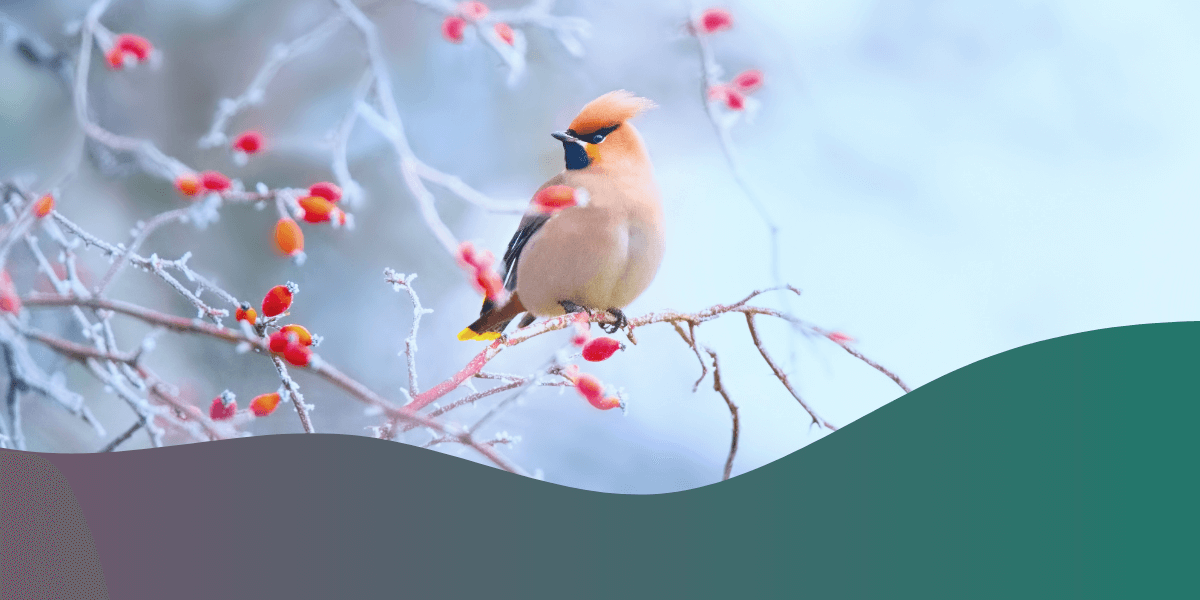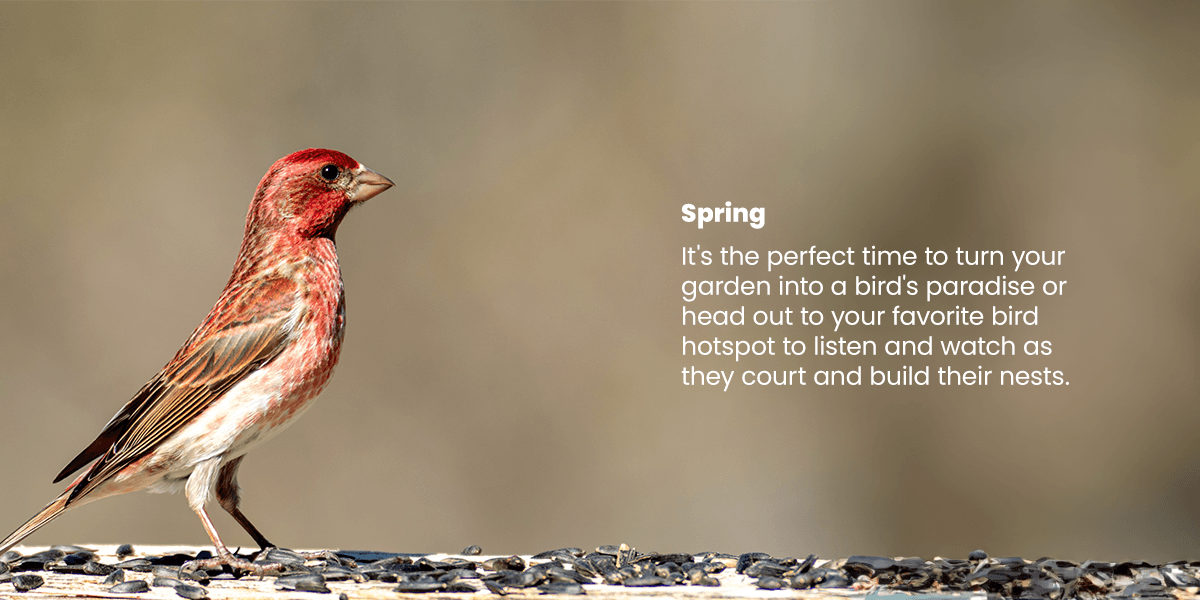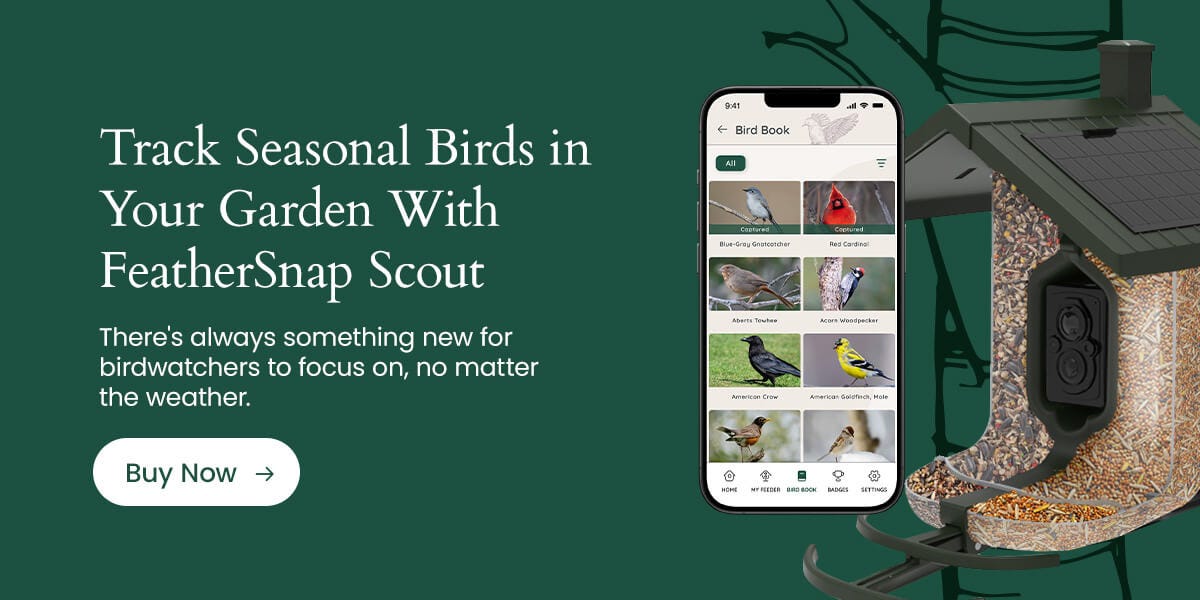

While most people look forward to weather changes throughout the year, birdwatchers get excited for a different reason. With the flurry of bird activity in spring and summer to the quieter months in fall and winter, each season has something new to discover. Learn more about the different birds and behaviors you'll see across the seasons to increase your knowledge and enjoyment of this rewarding hobby.
Spring
Spring is an exciting time full of activity and color for avid birdwatchers, as birds return home and begin their mating rituals. It's the perfect time to turn your garden into a bird's paradise or head out to your favorite bird hotspot to listen and watch as they court and build their nests.
You can expect the following benefits while birdwatching during spring.
- The arrival of migratory birds: Depending on where you live, you may see warblers, Baltimore orioles, American robins, common grackles and red-winged blackbirds return at the start of spring. This time of year is also when waterfowl like swans, ducks and geese explore ponds and predators like eagles, hawks and owls fly ahead and perch in trees.
- Breeding behaviors: Spring is the busiest time of year. Birds court, mate, build nests and incubate their eggs. Particularly with males, you'll see new, colorful plumage and courtship behavior such as dancing, preening, food sharing and wood pecking. You'll also notice more birds out and about as they hunt for worms and seeds along the ground and collect nesting material.
- Songbird concerts: One of the best parts of spring is the chorus of birdsong starting early in the morning. Birds sing to attract mates and defend their territories, so you'll hear more chatter during the breeding season. Keep an ear out to see which birds you can identify through their songs and calls.


Summer
Birdwatchers may see a decline in bird activity as the weather heats up. Even so, there are still plenty of exciting birding opportunities during summer. Consider waking up early or going for an evening walk — birds are more active during the cooler hours of the day. Don't forget your hat and sunblock!
Here's what to look for while birdwatching in summer.
- Nesting and parenting: Most birds settle down to care for their young after spring. They'll forage for food and keep a low profile. Adults will appear scruffier during this time as they molt their feathers. Observe the birds around you — often, you can follow birds carrying nesting material to see where their nests are.
- Juvenile birds: Closer to the middle of summer, you'll start seeing recently fledged baby birds learning to fly, sing and forage. These months are the perfect time to test your birding skills — juveniles can be harder to identify because they've just shed their downy feathers and haven't grown their adult plumage yet.
- Specialized summer species: Summer is an ideal time for birdwatching, as you'll get to see species that love the warmer temperatures. For example, Minnesota birdwatchers can spot grosbeaks, woodpeckers, chickadees and northern goshawks.
Fall
Birds must adapt to survive as winter creeps closer and the vegetation starts changing. During this time, birdwatches can look for the start of migration and observe how birds adapt to the new landscape.
What can you expect to see in autumn?
- Southward migration: Many species migrate to warmer climates in fall. In contrast to spring, this is a drawn-out process — there's no rush to claim territories and build nests. Avid birders can keep track of departures and arrivals to better understand the bird population in the area. You could also visit well-known migration hotspots to see large flocks of birds resting.
- Flocking behavior: During fall, various bird species tend to flock together to increase their chances of survival. In large numbers, these flocks can safely look for food while others keep watch for threats. You can observe these mixed-species flocks to see which birds are the leaders and how they interact with each other.
- Dietary changes: Birds must change their feeding habits to survive as the foliage changes and insects become scarcer. In fall, birds may visit feeders more to gain weight or store food for winter. You'll also see birds that usually hunt for insects move to feed in areas with berries and seeds.
Winter
Winter is the quietest season for birdwatchers, as many birds migrate to warmer climates and others buckle down to survive the cold. There are still ample opportunities for birding despite less activity. Layer up and head outdoors to see what the resident birds and waterfowl are up to.
Birdwatchers can enjoy these benefits of winter birding.
- Resident and wintering birds: Only some birds migrate in fall, leaving hardy species like cardinals behind even when it's cold and snowy. The fun part of birdwatching in winter is spotting and identifying which birds stay in your area after migration ends. When the temperature drops, you can help the birds by putting nutritious suet in your feeder and offering unfrozen water sources.
- Waterfowl and water-related species: Water birds are a popular attraction for winter birdwatchers. If you visit a local body of water, you'll see lots of activity from ducks and geese. Some species even court in the winter, so their plumage is extra bright and beautiful. Birdwatching near water sources will also increase your chances of bird sightings during the cooler months, as birds need water to survive.
- Birdwatching in snow-covered landscapes: Winter's tranquility and quietness make this season perfect for birdwatching. You can explore the wilderness with less interruption from others, and identify birds more easily thanks to the lack of foliage and the snowy backdrop. While spotting birds in winter may take a while, the experience is still enjoyable and will give you a new appreciation for the abundance of bird activity in spring.
Track Seasonal Birds in Your Garden With FeatherSnap Scout
There's always something new for birdwatchers to focus on, no matter the weather. Your backyard bird population will change with the seasons, making birding an enjoyable hobby you can do from the comfort of your home. Tracking which birds come and go from your yard has never been easier with the solar-powered, Wi-Fi-enabled FeatherSnap Scout smart birdfeeder.
Your feeder will use motion detection to capture high-resolution photos and videos of bird visits and alert you via our mobile app. You can identify each species with the AI feature and keep track of them in your Life Book. Additionally, we've built our feeders with durable materials that withstand temperature variations to limit birdwatching interruptions.
Purchase your FeatherSnap Scout smart birdfeeder today, and browse our blog to learn more about birdwatching!

